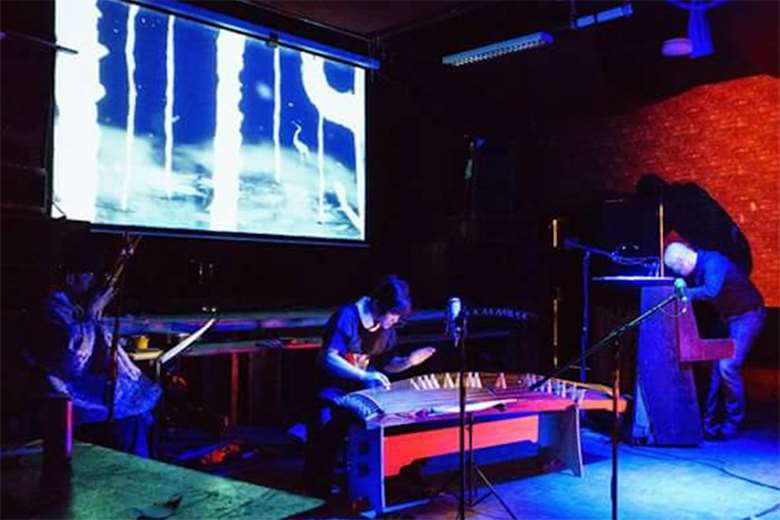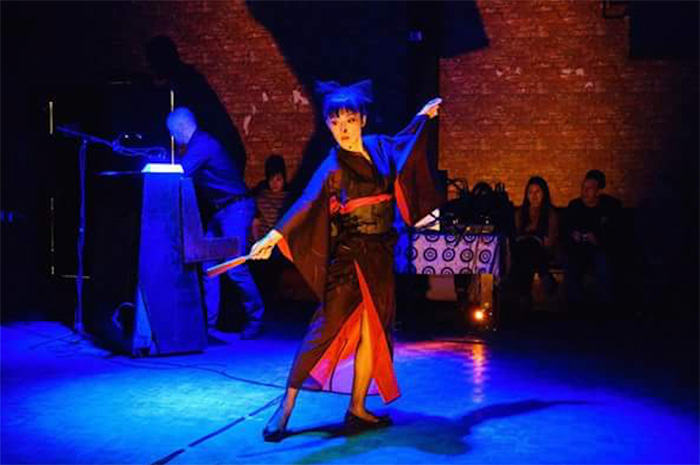Verity Lane journeys the Japanese sublime in North London
Monday, February 27, 2017
This multi-media production has a breadth of ambition that is matched by a depth of virtuosity.

Music, dance, poetry and animation are brought together with great coherence and discipline by an ensemble of performers marshalled by producer-composer and sound artist Verity Lane in a strikingly original exploration of Yugenism or 'the Japanese sublime'. In real terms that means that Lane, a Londoner who lived in Japan for a decade, collaborated with three animators and a traditional dancer to find an original take on the country's classical music, which yields a fluidly shifting narrative over four pieces – or sound installations – that have a darkly atmospheric, theatrical slant.
From the positioning of instruments to the lighting and changing configurations of the ensemble the work feels very much like a series of scenes, monologues and duets, an intimate tableau enhanced by the presence of no more than three musicians on stage at a given moment. In any case, the bass koto played by Etsuko Takezawa is as much dramatic objet d'art that irresistibly draws the audience's gaze as it is compelling source of sound. A gorgeously burnished curved wooden frame streaked with strings, ivory bridges and tuning pegs the instrument is akin to a pre-industrial loom or a small ship in the imaginary world evoked by Lane, a place where there is indeed a boat drifting in turbulent waters, blue butterflies, dancing leaves (borrowed from Wordsworth, no less) and cranes which duly assume human form.
Wearing thimbles on her fingertips Takezawa vividly weaves Lane's scores into life and the timbre of the koto is startling for the unique evocation of metal, silk and wood that has a faint undercurrent of bluesiness recast to a zither rather than guitar. The frequent slides of pitch create a sense of sound curling, quivering and wavering that reinforces the image of choppy sea, and this harmonises excellently with Liam Noble's piano in the latter stage of the piece where the dissonant pluck of the strings and rumbling low notes come well to the fore. Yet a marked relief from these more confrontational flurries is provided by Clive Bell's shakuhachi flute and Ko Ishikawa's sho, both of which introduce a serene, almost hypnotic warmth to the stage. The former is as much notes around breath as it is breath around notes, and Bell's unfailingly precise articulation is such that his long tones hover languorously in the air, while Ishikawa's chords, drawn from an instrument akin to both mouth organ and pan pipes, are well layered without being muffled. At times the melodies are like swirling mist.

All these sounds serve Lane's compositions, which have a stark, spare harmony, dot-dash motifs and a subtext of mystery that also permeates the other elements deployed in the production. Animations provided by Etienne Eve and Barry and Rowan O'Brien depict polychrome shapes while Kaho Aso's choreography is sharply mapped through obtuse and acute angles as if she were moving seamlessly between forest and sky as well as exaltation and endeavour. The steps frame the music with an apposite blend of beauty and gravitas.
Last year Evan Parker's collaboration with Noh musicians at King's Place was a highlight of Anglo-Japanese music in London. The fact that Lane unveiled this work at the T Chances venue in her birthplace, Tottenham, a manor that is not usually associated with avant-garde creativity, and that it is well attended by a predominantly local crowd, is a golden shot aimed at those who might choose to stereo-trash the area.
– Kevin Le Gendre
– Photos by Sean Kelly